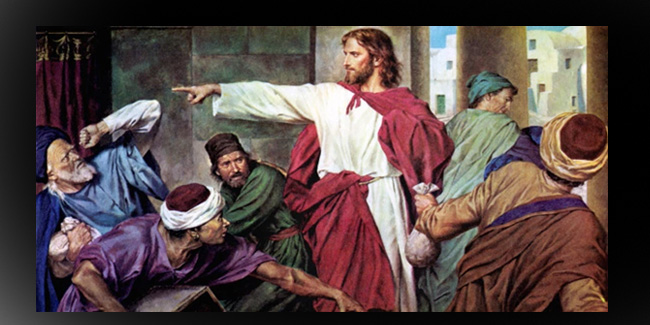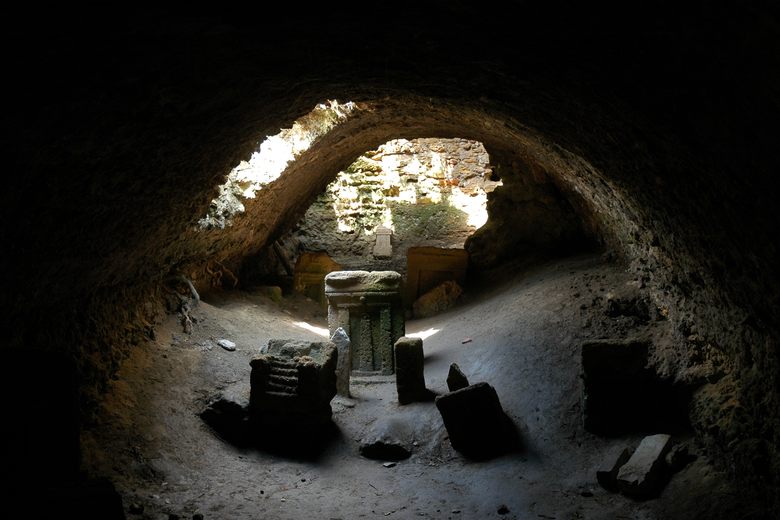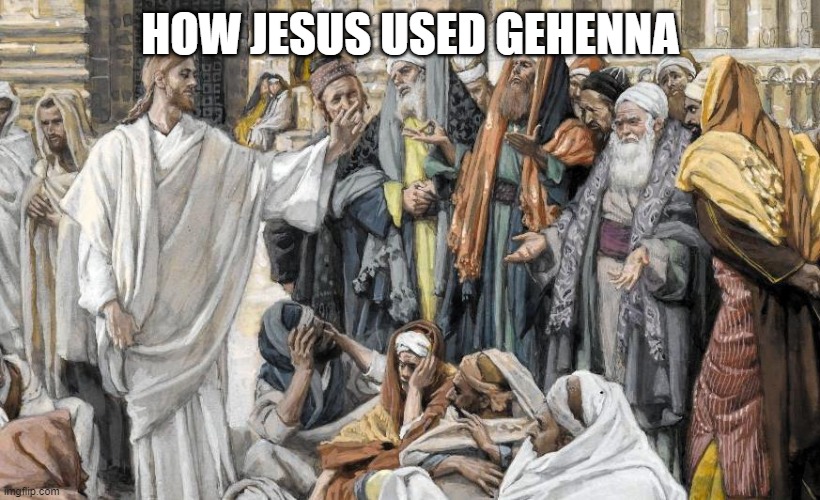Jesus's Usage of Gehenna
If you have been reading and following my blog articles up to this point, then you essentially have an idea about how Jesus utilized the term Gehenna, therefore, this will be a shorter post than usual as I intend only to review material that has been considered previously. If you have not yet read any of the Gehenna posts, the first one is HERE, and then they follow in sequential order.
The Geographical Hinnom Valley
Anyone who has ever investigated the topic of hell has undoubtedly uncovered the reality that Gehenna was (and still is) a literal, geographical place on earth that anyone can go and visit today. It is known as the Valley of Hinnom or the Hinnom Valley, both of which are a reduced version of the full name, The Valley of the Sons of Ben Hinnom. From a bird’s eye point of view, it is a ravine that stretches along the south to the southwest side of the city of Jerusalem. It likewise connects in the southernmost point with the Kidron Valley, which itself extends from the south to the south-east, to form one distinct valley that surrounds the city that somewhat resembles the shape of the letter “U.” It is beaming today with lush green trees and green grass that serves as a park where people can easily go today and have a picnic. However, what has transpired within the valley in the past is an entirely different story.

No one can claim that the Valley of Hinnom was ever a pleasant place due to its lengthy, horrendous, and ugly history. The violence and disgrace that occurred within the valley arose in the days of Israelite kings Ahaz and Manasseh, where multiple references in the Hebrew Bible state that both kings “passed their children through fire.” Though there is some debate as to whether the children were dead or alive when being either cremated and/or sacrificed (more on that subject HERE), what is clear is that regardless of the manner of death, realizing that their bodies were cremated in that valley was enough to cause considerable anxiety to any Jew at that time. This is due to the reason that in ancient Judaism, the belief that when one is cremated is an indication that they are unable to be resurrected at the end of time since no physical body remains to resurrect. Therefore, when anyone’s cause of death in the Bible is revealed due to cremation or death by fire, the “unwritten explanation” is that there shall be no afterlife and, consequently, no resurrection.
Jewish Burial Practices
In contrast to death by fire, having one’s corpse properly buried is essential to the deceased and their family within ancient Judaism. If someone is not buried in a traditional tomb or grave, and their corpse is instead indiscriminately cast aside in a field or on the side of the road for birds, maggots, and scavengers to come to devour, that would be considered one of the greatest and shameful incidents that a recently deceased Jewish individual could experience. Therefore, the numerous threats in the Bible of an individual’s corpse being tossed out or thrown aside in the open fields meant something significant to a Jew, and it was not a pleasant image. As a result, much like cremation, when one’s body is allowed to remain on the side of the road either to decay or for the scavengers to feed on, the implication is that there is no resurrection because there is no body left to resurrect—it has been completely consumed by animals.
The most notorious of these “corpse desecration passages” is Isaiah 66:24, which states, “And they shall go out and look on the dead bodies of the men who have rebelled against me. For their worm shall not die, their fire shall not be quenched, and they shall be an abhorrence to all flesh.” Jesus relates this particular verse from the OT prophet to Gehenna in Mark 9:47-48 when he states, “47 And if your eye causes you to sin, tear it out. It is better for you to enter the kingdom of God with one eye than with two eyes to be thrown into hell (Gehenna), 48 ‘where their worm does not die and the fire is not quenched.’ The worm (or maggot) does not reside in the fiery underworld of eternal torment but resides in a literal valley where countless bodies of those who rebelled against God are decomposing. “The worm shall not die” suggests the vast number of people who have rebelled against God is enormous because those worms will be too busy devouring the corpses to ever stop.

The Eternal Fire and the Eternal Worm
Likewise, “the fire is not quenched” indicates God’s judgment. In the same chapter in Isaiah 66, the author previously declared,
15 “For behold, the Lord will come in fire, and his chariots like the whirlwind, to render his anger in fury, and his rebuke with flames of fire. 16 For by fire will the Lord enter into judgment, and by his sword, with all flesh; and those slain by the Lord shall be many.”
Three separate times in these two verses, fire denotes God’s judgment on those who rebelled against Him. The inference ought not to be missed—flames of fire to an ancient Jew means cremation. Cremation means extreme shame and no resurrection for the deceased. The bodies of those rebellious enemies of God are first cast into an open field for maggots to consume (exceptionally shameful), and then they are burned by a fire that is “never quenched.” Much like the “eternal maggots,” the “eternal fire” is a literary overstatement suggesting that the fire that consumes the corpses is going to be so busy because of the excessive quantity of rebels that it will never cease burning. There is a double meaning in that passage recorded in classic, poetic exaggeration that is quite common to biblical authors.
Likewise, many assume the “eternal fire” is another biblical description indicating “hell.” However, the passage above from Isaiah expresses the severity of God’s judgment on His enemies by means of fire and that it shall never go out, which is the precise explanation of the problematic phrase “eternal fire.” During the final judgment, Jesus is frequently said to teach about hell in Matt 25. However, hell is not the focus in that infamous passage called “The Sheep and the Goats.” In this teaching, Jesus brings all the nations (Jew and Gentile) before him for final judgment. He then declares about his enemies, “Then he will say to those on his left, ‘Depart from me, you cursed, into the eternal fire prepared for the devil and his angels.’” The Devil and his angels are God’s enemies. Likewise, the nations who are sent to the eternal fire are the ones who rebelled against Jesus’s teaching and did not take care of the needy or less fortunate. The parallel between this statement from Jesus and Isaiah 66 is evident and must not be overlooked.
A Double Portion of Shame
If an individual’s corpse was left in the open to rot and be consumed by maggots, it would be considered extremely shameful. If a corpse is cremated, that that is likewise considered extremely shameful. With those two manners of death combined in one verse to indicate the approach that God will take to destroy His enemies, the implication is that they will also be shamed twice as much and in twice as much of a horrific and appalling manner. Nobody in ancient Judaism could envision the utter and complete horror of having their corpse left in the open to rot, be devoured by maggots and scavengers, and then be cremated afterward—let alone from God Himself.
The primary argument from this closing chapter in Isaiah is that those who rebelled against God are considered His enemies at the final judgment. Their punishment? They will be shamed twice as much by having their corpse exposed to rot and then cremated. The fear and terror that this image would arouse in the mind of a Jew must not be lost on the modern reader. It would be considered the most appalling, disgusting, and dreadful experience any individual would endure. Additionally, this “double-shaming” experience occurs in the precise location where young children were burned, cremated, and possibly sacrificed. It is the worst imagery imaginable.
No Honor, Just Shame
I have written much about honor and shame on this website (HERE) so it should be nothing new. Still, ancient Israel was a highly socialized honor and shame culture where an individual’s value or worth is built upon how society thought about them. Particularly when one passes away, the length of mourning, the type of burial, and even the place or tomb where one is buried was conducive to seeing how high or low a specific culture values that person. For example, suppose that when someone dies, there is nothing honorable about the manner of death or mourning. In that case, there is only shame. Yet twice as much shame as if only one of those shameful events befell an individual. That is precisely how Isaiah depicts God’s thoughts about His enemies.
Jesus’s Usage
All this history and context regarding the Hinnom Valley is precisely what Jesus was alluding to when he charged the Pharisees, “Woe to you, scribes and Pharisees, hypocrites! For you travel across sea and land to make a single proselyte, and when he becomes a proselyte, you make him twice as much a child of hell (Gehenna) as yourselves” (Matt. 23:15). Notice the phrase “child of Gehenna?” Where were the children cremated and, therefore, ultimately shamed by not being able to participate in the resurrection thanks to their parents? Gehenna.

Matthew 23:33 continues the threats levied on the Pharisees when Jesus declares, “You serpents, you brood of vipers, how are you to escape being sentenced to hell (Gehenna)?” Who was twice shamed in Isaiah, first by scavengers and then cremated by fire? The enemies of God. Who are the Pharisees in the Gospels? Enemies of God. Jesus is using the scriptures (what the Pharisees were experts in) and throwing it right back in their faces by exclaiming that they are the ones who are God’s enemies whom He will shame. That is in stark contrast to the Pharisaic notion that the Gentile nations were God’s enemies because the Jewish religious leaders believed only Jews would partake in the final resurrection.
Warning for Disciples
Fortuitously, however, the threats were constrained only to the Pharisees, but the disciples were advised about the dangers of Gehenna. Notice the parallels between bodily mutilation/desecration and fire as a judgment in Jesus’s statement in Matt. 5:29-30,
29 If your right eye causes you to sin, tear it out and throw it away. For it is better that you lose one of your members than that your whole body be thrown into hell (Gehenna). 30 And if your right hand causes you to sin, cut it off and throw it away. For it is better that you lose one of your members than that your whole body go into hell (Gehenna).
Suppose Christians insist that Gehenna simply meant “hell,” as in the future place of eternal torment (or annihilation or separation) of souls who are not Christians. In that case, it completely disconnects and withdraws Jesus’s statement of the “double-shame” context from Isaiah 66:24. The extremely shameful threat towards the Jewish leaders is gone. The warning of removing honorable body parts (honor) being significantly better than having your entire body tossed into the Hinnom Valley (shame), is gone. Being thrown into “hell” is not particularly shameful to a first-century Jew, but having your body thrown into the Hinnom Valley to be consumed by maggots and scavengers and then to be cremated, is exceptionally shameful. The concept of shame ought to be observed and regarded due to the particular sociological environment of Jewish culture.
It is incredibly perplexing if Gehenna meant hell, the place of eternal spiritual torment of non-Christians because no writer or speaker has ever used Gehenna as a metaphor for hell prior to Jesus. Therefore, would the Pharisees figure out that Jesus meant hell and not the actual Hinnom Valley? Likewise, would the disciples recognize that Jesus meant hell and not the valley itself? If hell was previously taught in Judaism, how did Jews understand that one go sent to “hell” before Jesus if only non-believers in Christ go there? Furthermore, the Bible never says anyone must believe in Jesus or go to Gehenna. Never.
How Did Jesus Use Gehenna?
Jesus applies the Gehenna proclamations in a similar fashion that the author of Isaiah 66:24 uses it—as a threat to God’s enemies. During Jesus’s time, however, God’s enemies were the Pharisees because they are the ones leading individuals away from God. Jesus’s usage of OT scripture (especially in Matthew) is tremendous in scope, and there is no reason to believe that he is taking something very familiar (the entire context of the OT scriptures surrounding the Hinnom Valley) and changing it into something unknown (eternal torment for non-Christians). The fires of the Hinnom Valley were always a symbol of shameful judgment for God’s enemies, even by the prophet Jeremiah who prophecies, “Therefore thus says the Lord God: Behold, my anger and my wrath will be poured out on this place, upon man and beast, upon the trees of the field and the fruit of the ground; it will burn and not be quenched” (Jer. 7:20).
After recognizing and appreciating the enormous amount of context necessary to entirely comprehend Gehenna and viewing the valley through the lens of an ancient Jewish individual, the subsequent warning from God in Jeremiah 7:32-34 demands no further explanation. It is abundantly clear to the reader who understands Gehenna as to what God is declaring to Jeremiah when He says
32 Therefore, behold, the days are coming, declares the Lord, when it will no more be called Topheth, or the Valley of the Son of Hinnom, but the Valley of Slaughter; for they will bury in Topheth, because there is no room elsewhere. 33 And the dead bodies of this people will be food for the birds of the air, and for the beasts of the earth, and none will frighten them away.
The Topheth
The Topheth is commonly understood as the “place of burning,” indicating that it is the exact place where the child sacrifice/cremation took place. God is thus saying, “some Israelites will bury their dead in the exact spot where the sacrifice/cremation took place, which is exceptionally shameful because the rest of the land will be littered with dead bodies for the birds, maggots, and scavengers.” Not something any Jew would want to hear from God because, much like cremation, when one’s body is left lying on the side of the road either to decay or for the scavengers, then there is no resurrection because there is no body to resurrect—animals have devoured it.

Conclusion
It is highly challenging to attempt to see Gehenna as the contemporary understanding of hell envisions it to be. No matter which view one holds about hell—traditionalism, annihilationism, or separationism—not one of these viewpoints can sufficiently account for how Gehenna is comparable with their personal idea of what hell is akin to. My next post will be about how Gehenna became “hell” and, thus, became a tradition in all churches. I hope and pray this series has been beneficial to someone because this is a grave and incredibly sensitive issue among Christians today. Try to say that you do not believe in hell during your subsequent Bible study and see what the repercussions will amount to. Yet countless people who make judgments such as that have no idea about anything remotely related to hell. I hope this issue gets some attention in the churches in the near future because there are some serious issues with so many Christians believing in the traditional form of hell.
Previous blog post on Mutilation and Dismemberment HERE
Next blog post on 3 Burning Questions about Hell HERE


